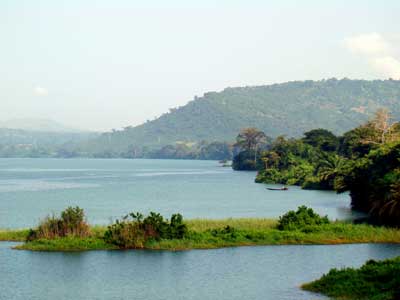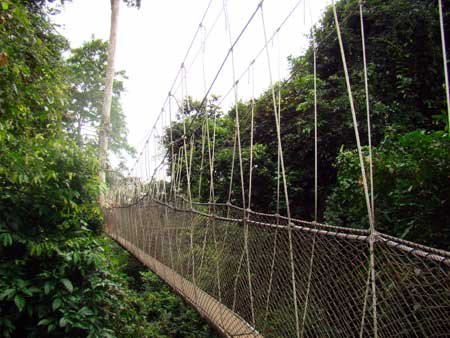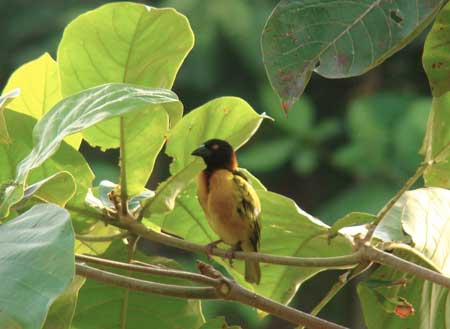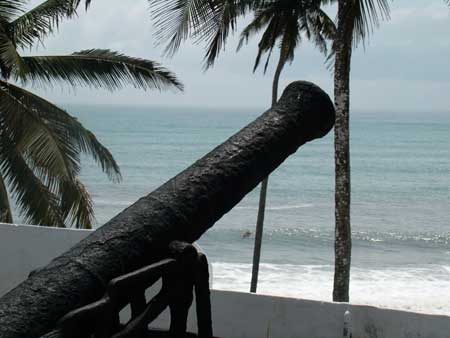
Lake Volta: I've never understood why such a salient geographical feature could be such a relatively untouristed region of Ghana. My friend Daniel first piqued my interest in a slide show that included an image of Lake Volta, much larger than I'd expected, and more beautiful. But the Bradt Travel Guide to Ghana says "Largely shunned by the package tourist industry -- it has been estimated that less than 5% of visitors to Ghana enter Volta region -- this scenic area is increasingly popular ... " It made a natural destination for me.
We drove northward and upward to Ho in the early evening, pleased to headed to the highlands and away from the sweltering heat of the coast. After nearly a year and a half living in Cotonou, visiting hill country is a rare luxury. A nearly full moon the color of peach wine rose over the Togo-Atakora range that stretch northeastward along Lake Volta's eastern flank all the way north to Pendjari in Benin, which we visited earlier. But what I'll always remember was the splendid and remarkable silence, because with the exception of the bird calls from the tree tops, the night was silent.
Continue reading "Lake Volta"

Perhaps one of Ghana's most famous tourist attractions is the relatively new Kakum National Forest canopy tour, constructed in 1995 with lots of donor inspiration (and money), so we went to give it a look one early morning before the sun was too high overhead. We shouldn't have worried -- it was hot and humid anyway; I was surprised how hot Ghana's tropical forest could really be, but the still air felt like liquid and the sweat ran down my face as we hiked up to where the canopy tour began.
Our guidebook says:
The Kakum complex of reserves protects at least 40 large mammal species, including the country's densest population of forest elephant, as well as giant forest hog, six types of duiker, bushbuck, bongo, various flying squirrels, leopard, spot-nosed monkey, Diana moneky, mona monkey and black-and-white and olive colobus.
We saw none of these.
Continue reading "A Walk in the Treetops: Kakum National Forest"

My most memorable explorations have always begun with a topographical map and a bit of insatiable curiosity. Such was the case back in the days I lived in Ithaca, New York, when my buddy Dave and I spent four full years tramping around the Finger Lakes region trying to reach deserted fishing holes or trying to figure out exactly what the bottom of a particularly isolated gorge must feel like when you look up the cliffsides. An old map from a 1960s National Geographic led me all the way out to Gaspesie to Ile Bonaventure. And our adventures in Ghana were no different.
The Bight of Benin is a slowly curving shoreline of sand flats that goes uninterrupted from Nigeria westward past Benin and Togo until you reach the eastern edge of Ghana, where the shoreline suddenly juts southward into the Atlantic. Just inside that bump is a broad lagoon by the name of Keta, and since we first landed in Africa it has caught my attention every time I looked at the map. So it was a natural place to go check out in late November when we visited Ghana for the first time, and we were not disappointed.
Continue reading "The Keta Lagoon"

When we traveled in Europe, the word "castle" was invariably preceded by the words "Rennaissance" or "medieval". In Africa it is preceded by the word "slave" This changes the nature of one of Ghana's most fascinating attractions in a dramatic way.
There is no escaping the legacy of slavery in Africa. This was one of the first things that surprised me when we first moved to Benin. It shouldn't have been surprising, but back home slavery was always presented as an important element of history. In Africa, slavery and its effects are very much a part of the present. In Benin this is dramatically evident in the Route of Slaves in Ouidah culminating in the Gate of No Return and the Monument of Reconciliation in Cotonou. In Ghana, where from 1600-1700 between 10,000 and 15,000 slaves were exported per year, the ghastly slave castles remain horrific monuments that bear silent tribute to a horrific practice.
Continue reading "The Slave Castles of Ghana"




